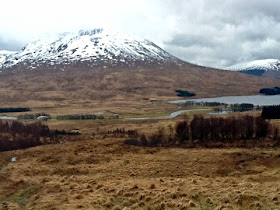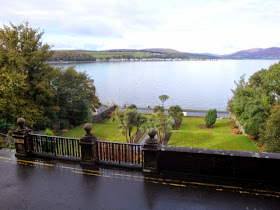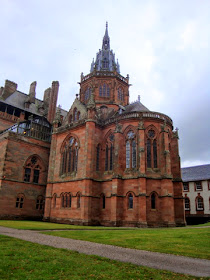This part of the west coast is one of beautiful lochs and small islands.
The island of Bute is reached by a short ferry crossing from Wemyss Bay across the Firth of Clyde to Rothesay. The ferry terminal is connected to a railway terminal and the complex dates back to Victorian times when the island was, and still is, a very popular tourist resort.
On the approach to Rothesay this fine building is prominent. Now a hotel, it was formerly a hydropathic establishment in the 19th century boom years of the Hydropathy movement.
The road east from Inveraray travels a torturous route through Glen Kinglas and over the interestingly named Rest and Be Thankful to Glen Croe before reaching Loch Long at Ardgarten and Arrochar on Loch Long.
Northern end of Loch Long
Looking south down Loch Long
The Ardgarten Hotel is situated on the north west side of Loch Long
at the foot of the 'Arrochar Alps'.
North of Inveraray is Loch Awe in Mid Argyle, 25 miles long and 1 mile wide. it is noted for its fishing. This remote area prospered when the railway arrived in 1877
The huge Victorian Loch Awe Hotel was built in 1881 and has its own railway station alongside. Parts of The Thirty Nine Steps and To Catch a Spy were filmed in this hotel.
Further north Loch Tulla lies on the edge of the Black Mount amidst increasingly beautiful highland scenery.
.JPG)
The little island of Seil is off the west coast south of Oban. It is separated from the mainland by the narrow stretch of water, Seil Sound, which is technically an arm of the Atlantic Ocean. The island is reached via Clachan Bridge which spans the sound and is known as ' The Bridge Over The Atlantic'. This picturesque single-arched bridge was designed by Thomas Telford in 1792.
Oban is a small tourist resort with a fine harbour. Here ferries sail to the Isle of Mull and other Hebridean islands.
The town is dominated by a huge edifice known as McCaig's Folly.
In 1897, John Stuart McCaig, an Oban banker and art critic, wanted to give work to the local unemployed men and at the same time to build a lasting memorial to himself. The result was the construction of a large granite replica of Rome’s Colosseum, still to be seen dominating a hill which overlooks the town. His grandiose scheme kept local stonemasons and labourers in work which continued until his death. Wonderful views over the town, harbour and islands are to be seen from a viewing platform near the folly.
Northern end of Loch Long
Looking south down Loch Long
The Ardgarten Hotel is situated on the north west side of Loch Long
at the foot of the 'Arrochar Alps'.
North of Inveraray is Loch Awe in Mid Argyle, 25 miles long and 1 mile wide. it is noted for its fishing. This remote area prospered when the railway arrived in 1877
The huge Victorian Loch Awe Hotel was built in 1881 and has its own railway station alongside. Parts of The Thirty Nine Steps and To Catch a Spy were filmed in this hotel.
Further north Loch Tulla lies on the edge of the Black Mount amidst increasingly beautiful highland scenery.
.JPG)
The little island of Seil is off the west coast south of Oban. It is separated from the mainland by the narrow stretch of water, Seil Sound, which is technically an arm of the Atlantic Ocean. The island is reached via Clachan Bridge which spans the sound and is known as ' The Bridge Over The Atlantic'. This picturesque single-arched bridge was designed by Thomas Telford in 1792.
Just over the bridge on the
island is an old highland pub called Tigh-An-Truish or ‘House of the Trousers'! Before the rebellion, highland soldiers were
not allowed to wear the kilt whilst serving in the army and when they returned
home on leave they changed into their kilts at the pub.
Oban is a small tourist resort with a fine harbour. Here ferries sail to the Isle of Mull and other Hebridean islands.
The town is dominated by a huge edifice known as McCaig's Folly.
In 1897, John Stuart McCaig, an Oban banker and art critic, wanted to give work to the local unemployed men and at the same time to build a lasting memorial to himself. The result was the construction of a large granite replica of Rome’s Colosseum, still to be seen dominating a hill which overlooks the town. His grandiose scheme kept local stonemasons and labourers in work which continued until his death. Wonderful views over the town, harbour and islands are to be seen from a viewing platform near the folly.
.JPG)






.JPG)







.JPG)




.JPG)


.JPG)

.JPG)




.JPG)


.JPG)



.JPG)



.JPG)

.JPG)


.jpg)
No comments:
Post a Comment